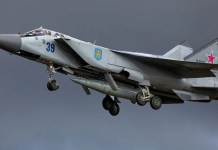The US Navy recently conducted a submarine-hunting drill using the MQ-9B SeaGuardian drone. The experiment was carried out in collaboration with the drone maker, General Atomics, off the coast of Southern California.
How India’s Help On Diego Garcia Will Make British PM Boris Johnson Grateful To Narendra Modi?
The San Diego-headquartered company successfully flight-tested the dispenser pod of the lethal drone. The test is said to be a part of a broader demonstration of anti-submarine warfare capabilities that are currently being developed for the MQ-9B SeaGuardian drone.
The latest effort is aimed at making submarine-hunting easier and more cost-effective than it is with the existing technology.
The MQ-9 Reaper, also known as ‘Predator B,’ is an unmanned aerial vehicle (UAV) capable of remotely controlled or autonomous flight operations. The drone had been developed by General Atomics Aeronautical Systems (GA-ASI) primarily for the United States Air Force (USAF).
The Reapers have been designed as an “armed, multi-mission, medium-altitude, long-endurance” aircraft to carry out offensive strikes.
The US Air Force refers to the MQ-9 and other UAVs as ‘remotely piloted vehicles/aircraft’ (RPV/RPA). The MQ-9 platform, which is currently the company’s premier RPAS, is available in three configurations known as the Protector, the SkyGuardian, and a navy-variant called SeaGuardian.

Converted from General Atomics’ earlier Naval Reaper concept, the SeaGuardian drone is the maritime surveillance drone, which has an endurance of more than 18 hours and can mount an eight-hour patrol at a radius of 1,200 nautical miles.
The drone was used during a demonstration conducted in cooperation with the US Navy, over the expansive test ranges off the coast of Southern California.
The data gathered during the exercise was transmitted to a ground operations center, hundreds of miles away at the US Army’s Yuma Proving Ground in Arizona.
Under the latest test, the pods of the drone were used to release sonobuoys, which are relatively small buoy expendable sonar systems.
The sonobuoys are dropped or ejected from aircraft or ships conducting anti-submarine warfare or underwater acoustic research.
According to General Atomics, the new pods will also boast the ability to launch precision-guided munitions, as well as small unmanned aircraft.
At the time of the test, the MQ-9A carried one of the 10-tube dispenser pods and other anti-submarine warfare (ASW) related systems.
The Reaper drone was able to find and track an expendable anti-submarine warfare training target for three hours with the help of General Dynamics’ UYS-505 acoustic processing software.
David Alexander, president of General Atomics Aeronautical Systems, said in a statement, “This demonstration is a first for airborne ASW. The successful completion of this testing paves the way for the future development of more Anti-Submarine Warfare capabilities from our MQ-9s,
“We look forward to continuing collaboration with the U.S. Navy as they explore innovative options for distributed maritime operations in the undersea domain.”
The MQ-9 drone deployed around 10 sonobuoys which included — one AN/SSQ-36B, two AN/SSQ-62F Directional Command Activated Sonobuoy Systems (DICASS), and seven AN/SSQ-53G Directional Frequency Analysis and Recording (DIFAR) buoys.
While the AN/SSQ-36B is a bathythermograph type that detects underwater objects by changes in water temperature, the DICASS is equipped with active sonar, and the DIFAR passively gathers acoustic data.
The data gathered was then sent across to the personnel on the ground, who were then able to successfully spot and track a Navy Mk 39 Expendable Mobile Anti-Submarine Warfare Training Target (EMATT).
Built by Lockheed Martin, the EMATT is a small torpedo-shaped device that simulates the acoustic and other signatures of a full-sized submarine.
Amid Russia’s announcement that it will equip its submarines with new expendable electronic warfare jammers as a countermeasure, the recent US exercise highlighted the crucial role of the sonobuoys in modern ASW operations.
This is even more alarming considering that there has been intelligence of both Russia and China steadily increasing the size of their submarine forces. This includes the introduction of more advanced designs with several new features that make the submarines even harder to detect and track underwater.
The latest exercise stresses the advantages that the MQ-9 drones or any other type of drones bring to the table when equipped with sonobuoys.
The drones would clearly lessen the pressure on manned maritime patrol aircraft, while also serving as a cost-efficient means of deploying buoys over a broad region.
Authors Profile
Follow EurAsian Times on Google News





